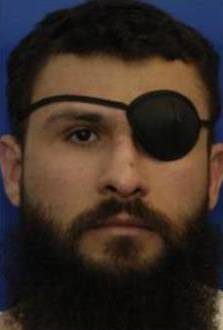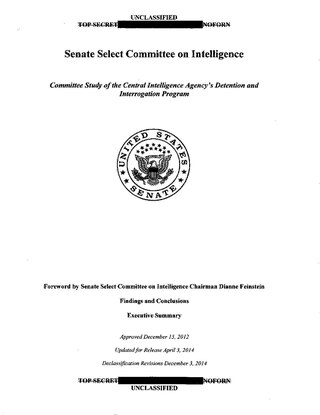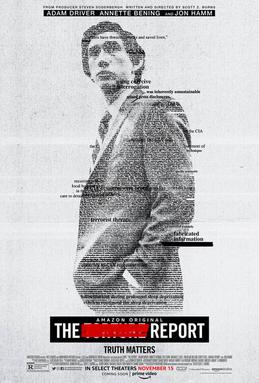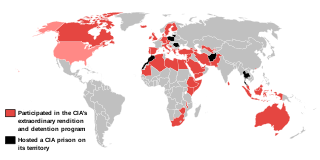Related Research Articles

Abu Zubaydah is a Palestinian citizen born in Saudi Arabia currently held by the U.S. in the Guantanamo Bay detention camp in Cuba. He is held under the authority of Authorization for Use of Military Force Against Terrorists (AUMF).

Khalid Sheikh Mohammed, often known by his initials KSM, is a terrorist, mechanical engineer and the former Head of Propaganda for al-Qaeda. He is currently held by the United States at the Guantanamo Bay detention camp under terrorism-related charges. He was named as "the principal architect of the 9/11 attacks" in the 2004 9/11 Commission Report.

Waterboarding is a form of torture in which water is poured over a cloth covering the face and breathing passages of an immobilized captive, causing the person to experience the sensation of drowning. In the most common method of waterboarding, the captive's face is covered with cloth or some other thin material and immobilized on their back at an incline of 10 to 20 degrees. Torturers pour water onto the face over the breathing passages, causing an almost immediate gag reflex and creating a drowning sensation for the captive. Normally, water is poured intermittently to prevent death; however, if the water is poured uninterruptedly it will lead to death by asphyxia. Waterboarding can cause extreme pain, damage to lungs, brain damage from oxygen deprivation, other physical injuries including broken bones due to struggling against restraints, and lasting psychological damage. Adverse physical effects can last for months, and psychological effects for years. The term "water board torture" appeared in press reports as early as 1976.

Ammar al-Balushi or Amar Baloch; born Ali Abdul Aziz Ali on 29 August 1977) is a Pakistani (Balochi) citizen who has been in American custody at the Guantanamo Bay detention camp since 2006. He was arrested in the Pakistani city of Karachi in 2003 before being transferred; the series of criminal charges against him include: "facilitating the 9/11 attackers, acting as a courier for Osama bin Laden and plotting to crash a plane packed with explosives into the U.S. consulate in Karachi." He is a nephew of the Pakistani terrorist Khalid Sheikh Mohammed, who served as a senior official of al-Qaeda between the late 1980s and early 2000s; and a cousin of the Pakistani terrorist Ramzi Ahmed Yousef, who played a key role in the 1993 World Trade Center bombing, the Philippine Airlines Flight 434 bombing, and the high-profile Bojinka plot.

Abd al-Rahim Hussein Muhammed Abdu al-Nashiri is a Saudi Arabian citizen alleged to be the mastermind of the bombing of USS Cole and other maritime attacks. He is alleged to have headed al-Qaeda operations in the Persian Gulf and the Gulf states prior to his capture in November 2002 by the CIA's Special Activities Division.

Jose A. Rodriguez Jr. is an American former intelligence officer who served as Director of the National Clandestine Service of the Central Intelligence Agency (CIA). He was the final CIA deputy director for operations (DDO) before that position was expanded to D/NCS in December 2004. Rodriguez was a central figure in the 2005 CIA interrogation videotapes destruction, leading to The New York Times Editorial Board and Human Rights Watch to call for his prosecution.
"Enhanced interrogation techniques" or "enhanced interrogation" was a program of systematic torture of detainees by the Central Intelligence Agency (CIA), the Defense Intelligence Agency (DIA) and various components of the U.S. Armed Forces at remote sites around the world—including Abu Ghraib, Bagram, Bucharest, and Guantanamo Bay—authorized by officials of the George W. Bush administration. Methods used included beating, binding in contorted stress positions, hooding, subjection to deafening noise, sleep disruption, sleep deprivation to the point of hallucination, deprivation of food, drink, and medical care for wounds, as well as waterboarding, walling, sexual humiliation, rape, sexual assault, subjection to extreme heat or extreme cold, and confinement in small coffin-like boxes. A Guantanamo inmate's drawings of some of these tortures, to which he himself was subjected, were published in The New York Times. Some of these techniques fall under the category known as "white room torture". Several detainees endured medically unnecessary "rectal rehydration", "rectal fluid resuscitation", and "rectal feeding". In addition to brutalizing detainees, there were threats to their families such as threats to harm children, and threats to sexually abuse or to cut the throat of detainees' mothers.

John Chris Kiriakou is an American author, journalist and former intelligence officer. Kiriakou is a columnist with Reader Supported News and co-host of Political Misfits on Sputnik Radio.
The CIA interrogation videotapes destruction occurred on November 9, 2005. The videotapes were made by the United States Central Intelligence Agency (CIA) during interrogations of Al-Qaeda suspects Abu Zubaydah and Abd al-Rahim al-Nashiri in 2002 at a CIA black site prison in Thailand. Ninety tapes were made of Zubaydah and two of al-Nashiri. Twelve tapes depict interrogations using "enhanced interrogation techniques", a euphemism for torture. The tapes and their destruction became public knowledge in December 2007. A criminal investigation by a Department of Justice special prosecutor, John Durham, decided in 2010 to not file any criminal charges related to destroying the videotapes.

Ali H. Soufan is a Lebanese-American former FBI agent who was involved in a number of high-profile anti-terrorism cases both in the United States and around the world. A 2006 New Yorker article described Soufan as coming closer than anyone to preventing the September 11 attacks and implied that he would have succeeded had the CIA been willing to share information with him. He resigned from the FBI in 2005 after publicly chastising the CIA for not sharing intelligence with him which could have prevented the attacks.
James Elmer Mitchell is an American psychologist and former member of the United States Air Force. From 2002, after his retirement from the military, to 2009, his company Mitchell Jessen and Associates received $81 million on contract from the CIA to carry out the torture of detainees, referred to as "enhanced interrogation techniques" that resulted in little credible information.

Abu Zubaydah is a Saudi citizen who helped manage the Khalden training camp in Afghanistan. Captured in Pakistan on March 28, 2002, he has since been held by the United States as an enemy combatant. Beginning in August 2002, Abu Zubaydah was the first prisoner to undergo enhanced interrogation techniques. There is disagreement among government sources as to how effective these techniques were; some officials contend that Abu Zubaydah gave his most valuable information before they were used; CIA lawyer John Rizzo said he gave more material afterward.
In 2003, a secret compound, known as Strawberry Fields, was constructed near the main Guantanamo Bay detention camps, in Cuba. In August 2010 reporters found that it had been constructed to hold CIA detainees classified as "high value". These were among the many men known as ghost detainees, as they were ultimately held for years for interrogation by the CIA in its secret prisons known as black sites at various places in Europe, the Mideast, and Asia, including Afghanistan.

John Bruce Jessen is an American psychologist who, with James Elmer Mitchell, created the so-called "enhanced interrogation techniques" that were used in the interrogation and torture of CIA detainees and outlined in the United States Senate Select Committee on Intelligence's report on CIA torture. In that report, he was mentioned under the pseudonym "Hammond Dunbar." His company, Mitchell Jessen and Associates, earned US$81 million for its work.

Scott Shane is an American journalist and author, employed by The New York Times until 2023, reporting principally about the United States intelligence community. In 2023, his nonfiction book Flee North: A Forgotten Hero and the Fight for Freedom in Slavery's Borderland was published by Celadon Books.
Alfreda Frances Bikowsky is a Central Intelligence Agency (CIA) officer who has headed the Bin Laden Issue Station and the Global Jihad unit. Bikowsky's identity is not publicly acknowledged by the CIA, but was deduced by independent investigative journalists in 2011. In January 2014, the Washington Post named her and tied her to a pre-9/11 intelligence failure and the extraordinary rendition of Khalid El-Masri. The Senate Intelligence Committee report on CIA torture, released in December 2014, showed that Bikowsky was not only a key part of the torture program but also one of its chief apologists, resulting in the media's giving her the moniker "The Unidentified Queen of Torture."

The Committee Study of the Central Intelligence Agency's Detention and Interrogation Program is a report compiled by the bipartisan United States Senate Select Committee on Intelligence (SSCI) about the Central Intelligence Agency (CIA)'s Detention and Interrogation Program and its use of torture during interrogation in U.S. government communiqués on detainees in CIA custody. The report covers CIA activities before, during, and after the "War on Terror". The initial report was approved on December 13, 2012, by a vote of 9–6, with seven Democrats, one Independent, and one Republican voting in favor of the report and six Republicans voting in opposition.

Gina Cheri Walker Haspel is an American intelligence officer who was the director of the Central Intelligence Agency (CIA) from May 21, 2018, to January 20, 2021. She was the agency's deputy director from 2017 to 2018 under Mike Pompeo, and became acting director on April 26, 2018, after Pompeo became U.S. secretary of state. She was later nominated and confirmed to the role, making her the first woman to become CIA director on a permanent basis.

The Report is a 2019 American historical political drama film written and directed by Scott Z. Burns that stars Adam Driver, Annette Bening, Jon Hamm, Ted Levine, Michael C. Hall, Tim Blake Nelson, Corey Stoll, and Maura Tierney. It depicts the efforts of staffer Daniel Jones as he led the Senate Intelligence Committee's investigation of the Central Intelligence Agency's use of torture following the September 11th attacks, covering more than a decade's worth of real-life political intrigue related to the contents, creation, and release of the 6,700-page Senate Intelligence Committee report on CIA torture.

Following the September 11 attacks of 2001 and subsequent War on Terror, the United States Central Intelligence Agency (CIA) established a "Detention and Interrogation Program" that included a network of clandestine extrajudicial detention centers, officially known as "black sites", to detain, interrogate, and often torture suspected enemy combatants, usually with the acquiescence, if not direct collaboration, of the host government.
References
- ↑ Leonard, Tom (June 22, 2008). "Khalid Sheikh Mohammed: The interrogator who made him talk". Telegraph. Retrieved June 15, 2015.
- 1 2 3 4 5 Shane, Scott (June 22, 2008). "Inside a 9/11 Mastermind's Interrogation". New York Times. Retrieved January 24, 2012.
- 1 2 Hoyt, Clark (July 6, 2008). "Weighing the Risk". New York Times. Retrieved June 15, 2015.
- ↑ Shane, Scott (August 11, 2009). "Interrogation Inc. - 2 U.S. Architects of Harsh Tactics in 9/11's Wake". New York Times. Retrieved January 24, 2012.
- ↑ "Editors' Note". New York Times. June 22, 2008. Retrieved January 24, 2012.
- ↑ Savage, Charlie (January 24, 2012). "Ex-C.I.A. Officer Charged in Information Leak". New York Times. Retrieved January 24, 2012.
- ↑ Shane, Scott (January 5, 2013). "Ex-Officer Is First From C.I.A. to Face Prison for a Leak". New York Times. Retrieved January 7, 2013.
- ↑ Savage, Charlie (October 23, 2012). "Former C.I.A. Operative Pleads Guilty in Leak of Colleague's Name". New York Times. Retrieved January 7, 2013.